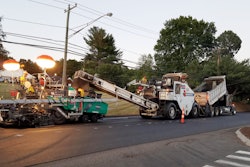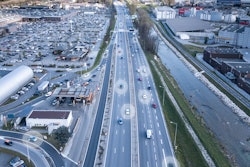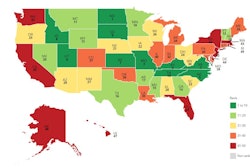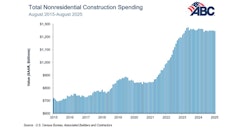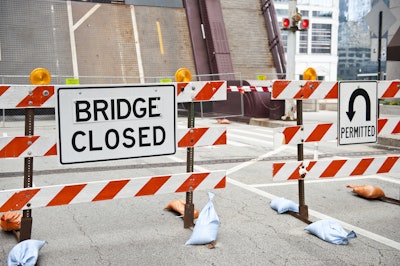
There are more than 617,000 bridges across the United States. Currently, 42% of all bridges are at least 50 years old, and 46,154, or 7.5% of the nation’s bridges, are considered structurally deficient, meaning they are in “poor” condition. According to the American Society of Civil Engineers (ASCE) what that boils down to is American are crossing deteriorating bridges 178 million times a day.
The Federal Highway Administration (FHWA) says ratings are given for different bridge components: the deck, superstructure, substructure and culvert. The Pennsylvania Department of Transportation says these ratings range from 0-9. The higher the rating, the better the condition of the bridge. If the lowest rating is 7 or higher, the bridge is in good condition, according to the FHWA. If the lowest rating is 5 or 6, then the bridge is characterized as in fair condition. Ratings 4 or lower mean the bridge is in poor condition.
The Infrastructure Investment & Jobs Act (IIJA) makes the single largest dedicated bridge investment since the construction of the interstate highway system and the included Bridge Investment Act establishes a bridge investment program to award competitive grants to certain governmental entities for projects that improve the condition of bridges as well as the safety, efficiency and reliability of the movement of people and freight over bridges.
According to the American Road & Transportation Builders Association (ARTBA), the states with the highest percentage of bridges in poor condition are:
- West Virginia: 21%
- Iowa: 19.1%
- Rhode Island: 19%
- South Dakota: 17.7%
- Pennsylvania: 14.6%
- Maine: 12.7%
- Louisiana: 12.7%
- Puerto Rico: 12.1%
- Michigan: 10.8%
- North Dakota: 10.3%
Here are the bridges in each of these states that are in "poor condition" that have the most traffic crossing them each day:
West Virginia:
More than 90 of the state’s structurally deficient bridges are on interstate highways, and nine of the 10 most traveled ones were on interstate highways. The most traveled one was I-64.
Built in 1974, the I-64 Bridge over county route 61/12 (Kanawha Turnpike) has over 86,494 daily crossings. In 2020, the state did replace the bridge deck and the state hopes that will raise the condition of the bridge to "fair" condition on the next inspection.
Iowa:
In 2016, Iowa would have ranked first on this list. Of its 24,043 bridges, the FHWA classified 19% (4,575 bridges) of them as structurally deficient in 2019. This is down from 4,719 in 2015.
Only six of the state’s structurally deficient bridges are on interstate highway systems. The most traveled structurally deficient bridge was the Rock Island Centennial Bridge, which is part of U.S. Highway 67. Despite more than $11 million in structural upgrades in 2005, it remains one of the most structurally deficient bridges in Iowa. Opened in 1940, it stretches across the Mississippi River, connecting Davenport, Iowa, to Rock Island, Illinois. In 2017, the bridge was officially renamed as the Master Sgt. Stanley Talbot Memorial Bridge.
Rhode Island:
Of the 777 bridges in the state, 148, or 19.0 percent, are classified as structurally deficient. This means one of the key elements is in poor or worse condition. All 10 of the most traveled structurally deficient bridges were in Providence County, which includes the capital city of Providence.
The most traveled was I-95 over U.S. Highway 6. The bridge was built in 1964 and is part of the Providence I-95 Viaduct, which crosses the Woonasquatucket River and Amtrak lines.
South Dakota:
Of the 5,880 bridges in the state, 1,038, or 17.7 percent, are classified as structurally deficient. This means one of the key elements is in poor or worse condition.
Only three of the state’s structurally deficient bridges are on interstate highway systems.
Four of the 10 most traveled structurally deficient bridges were in Minnehaha County, which includes the city of Sioux Falls. However, the most traveled one was in Brown County, where U.S. Highway 12 crosses Moccasin Creek near Aberdeen. The bridge was built in 1954 and was rated the most structurally deficient bridge in South Dakota in 2018.
Pennsylvania:
Of the 22,965 bridges in the Commonwealth, 3,353, or 14.6 percent, are classified as structurally deficient. This means one of the key elements is in poor or worse condition.
About 100 of the state’s structurally deficient bridges are on interstate highways. Nine of the 10 most traveled structurally deficient bridges were in Philadelphia County, which includes the entire city of Philadelphia. The most traveled was the I-95 bridge over Comly Street, near the Wissinoming section of the city. The bridge was built in 1967.
The Pennsylvania Department of Transportation (PennDOT) announced in March 2020 that construction would begin later that month on a project to reconstruct and improve I-95, including replacement of the bridge above Comly Street. Construction of the northbound lanes could be done by autumn 2021, with southbound work finished in 2022.
Maine:
Of the 2,472 bridges in the state, 315, or 12.7 percent, are classified as structurally deficient. This means one of the key elements is in poor or worse condition.
The majority of the structurally deficient bridges were in Cumberland County Maine’s bridges most in need of help are concentrated in northern and rural areas. Only 59 of Penobscot County’s 295 bridges are in “good” condition, according to the federal DOT, while 42 are in “poor” condition. Cumberland, Hancock, Washington and Somerset counties have the highest percentages of bridges in “poor” condition, each totaling more than 20 percent.
The state fell behind in its bridge maintenance because of the pandemic, according to Maine Department of Transportation spokesperson Paul Merrill.
Louisiana
Of the 12,853 bridges in the state, 1,634, or 12.7 percent, are classified as structurally deficient. This means one of the key elements is in poor or worse condition.
According to Louisiana officials, the backlog of maintenance in the state sits at $15 billion. Simply put, that’s a $15 billion wish list for new bridges and other interstate projects like the Calcasieu River Bridge. But with Louisiana expected to receive just about $7 billion from the infrastructure package, it’ll still need to get money elsewhere.
Puerto Rico
Of the 2,334 bridges in the Commonwealth, 282, or 12.1 percent, are classified as structurally deficient. This means one of the key elements is in poor or worse condition. Almost all of these bridges are in San Juan County.
36 of the structurally deficient bridges are on the Interstate Highway System. A total of 74.8 percent of the structurally deficient bridges are not on the National Highway System, which includes the Interstate and other key roads linking major airports, ports, rail and truck terminals.
Michigan
Of the 11,271 bridges in the state, 1,219, or 10.8 percent, are classified as structurally deficient. This means one of the key elements is in poor or worse condition.
The bipartisan infrastructure bill will help to address the critical need for infrastructure repairs, sending more than $7.3 billion dollars to Michigan to help fix roads and bridges over the next 5 years but it's not enough.
“We are extremely excited that the federal government has taken this step. It's certainly more money than we've seen since the 1940s, when our highway system was built first time,” says Lance Binoniemi, VP of government affairs at the Michigan Infrastructure and Transportation Association. "It's not $7.3 billion of additional money; it is $1.7 billion of additional money, which is a lot of money and it's going to do a lot of good for the state, but it certainly doesn't solve our overall long-standing problem that we have."
North Dakota
Of the 4,312 bridges in the state, 444, or 10.3 percent, are classified as structurally deficient. This means one of the key elements is in poor or worse condition.
South Dakota should expect to receive $1.9 billion in federal aid for highway projects over the next five years under the recently approved federal infrastructure package. But that is not the only money that would come to South Dakota. The state would also receive $225 million for bridge repair, $124 million for public transition and additional millions for other projects including broadband improvements.
ARTBA said South Dakota has identified 2,477 bridges in need of some repair at an estimated cost of $992.9 million.
The infrastructure bill will sure help address the nation's failing bridges, but will it be enough? Before the IIJA was enacted, ARTBA estimated it would take 40 years to fix all of the nation's structurally deficient bridges. I guess it's time to get to work.





